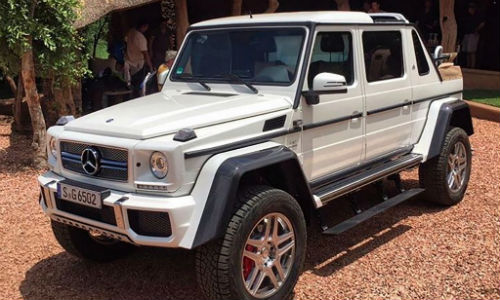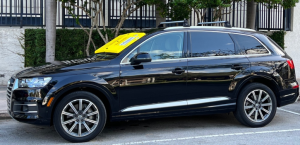By Jeff Sanford
Toronto, Ontario — March 16, 2017 — This week’s edition of Friday Fun looks at the upcoming release of the world’s most expensive SUV, how President Trump’s plans to roll back fuel efficiency may end up costing people at the pump, yet more fallout from the emissions scandal and much, much more!
– Mercedes-Benz will release the world’s most expensive SUV in 2018. Technically, you could probably find one that’s more expensive if you look into custom builds, but we all know that doesn’t count. This thing is a production vehicle and it’s supposed to cost something like $300,000 USD. The Maybach G650 will have a convertible top and thermal cup holders among many other features. The truck will be a leader in the burgeoning class of “ultra-luxurious all-terrain vehicles.” Better act quick if you want to get your hands on one. It will be limited to a run of 99. The SUV will have a V12 engine and a retractable fabric roof in the back.
– Ford is testing 3-D printing for prototyping, low-volume cars according to a report by our content partner, Repairer Driven News. The company could, “… build prototypes and generate actual production parts like spoilers using a gigantic 3-D printer at its Dearborn, Mich., headquarters.” According to the report, “Ford is the first automaker to pilot the Stratasys Infinite Build 3-D printer, a device the size of a room which can spit out ‘automotive parts of practically any shape or length,’ according to the OEM. The machine can 3-D print pieces up to six feet in length. Eventually, lower-volume vehicles could receive 3-D-printed parts. According to the report, “… 3D printing is not yet fast enough for high-volume manufacturing, but it is more cost efficient for low-volume production.”
– The Amelia Island Concours d’Elegance took place in Florida this week. Up for sale was a 365kw 2007 Ferrari F430 once owned by President Trump. According to a media report, “The now President bought the car new for about $288,000. Garaged in Trump Tower, Don didn’t use the car a lot, selling it in 2011 with under 4,000 km on the clock. The only supercar owned by a president of the US, the bright red Ferrari coupe still has only done 10,000km.” One analyst suggested the car could sell for $400,000 as a result of the Trump connection. Normally it would be worth about $130,000. Trump has also owned a V12 1997 Lamborghini Diablo with a custom Le Mans blue paint job. Another piece from Trump’s auto history: In 1988, “… the Trumpster joined forces with Cadillac to market ‘the most opulent stretch limousine made’, the Trump Golden Series, with a fax, paper shredder, VCR and plenty of rosewood trim. Two were sold.”
The only American cars in Trump’s current collection are two Cadillacs and a Tesla. He also has a “… vintage Rolls Phantom, a newish Rolls Silver Cloud, a Maybach, Mercedes S600 and Mercedes SLR McLaren.”
– Some wild late winter weather led to a series of bizarre accidents across the country last week. One of the biggest was in Quebec. The mayor of Montreal, Denis Coderre, has stated that the response by emergency personnel was “unacceptable.” On Thursday, as a major snowstorm settled in, more than 300 cars were stranded on Highway 13 where it runs through Dorval and Lachine. The first accident on the highway was reported at 6 p.m. Cars began to pile up after that. Around midnight the transport ministry “communicated” with Montreal’s civil security department, but did not mention that people were stranded. The highway was not closed until midnight. Only at 3:27 a.m. did the Sûreté du Québec call the Montreal fire department to request help in evacuating those trapped on the highway. It wasn’t until 4:30 a.m. that two buses showed up in response. Some of those trapped spent 13 hours on the highway. According to a report, it wasn’t until 5:24 a.m. that a shelter was opened in Lachine to accommodate people who had abandoned their cars and had walked off the expressway.
– Also this week: The 401 East was closed near Brockville, Ontario when a semi carrying a toxic chemical overturned. One of those who inhaled the chemical died in the hallway at a nearby hospital. Several others were injured.
– A different section of the 401 was closed in Toronto after a bus rolled over. The driver was injured, but luckily there were no passengers on the bus at the time.
– Will the shift to greater use of special materials in car bodies come to an abrupt halt? Could be. A report by CNN notes that President Trump visited Michigan this past week and announced he will, “… reinstate a midterm review of tougher U.S. vehicle fuel economy standards that were brought in during the Obama administration.” Trump made the announcement at the American Center for Mobility in Ypsilanti, Michigan. “We want to be the car capital of the world again,” Trump told the audience. One report notes that, “After lengthy negotiations with car makers, the Obama administration had set the standards in 2012. As written, the standards would phase in a new fleet of vehicles that would average more than 50 mpg in 2015.”
That schedule had been widely credited with kicking off an industry wide drive towards lightweighting vehicles. But Trump now wants to reverse that decision. One report notes that, “With steady improvement in fuel efficiency, these standards would save consumers $4,000 at the pump over the life of their cars. That’s $1 trillion nationwide — and more if gas prices rise. One week before Obama left office, the EPA completed an exhaustive analysis of the standards’ impact and feasibility, and determined there was no reason to change them. Yet, at the urging of General Motors’ CEO Mary T. Barra, Ford’s CEO Mark Fields and the industry trade association, the Trump administration is reported to be about to reverse that decision.”
The report also notes that the new rules, “… have saved Americans $35 billion in gasoline and would keep about 6 billion tons of carbon dioxide out of the atmosphere, the biggest single step any nation will have taken to fight global warming.”
– The CEO of Audi found it necessary to assure the auto press this week that the raids conducted on that company’s head office as part of an EU investigation in the ongoing emissions scandal did not involve a raid at his home. Audi has now become a part of the emissions investigation. Officials spent a couple of days at the company’s head office collecting documents.
– Another bit of fallout from the emissions scandal? Volkswagen Chief Executive Matthias Mueller said he, “… did not rule out he could hold merger talks with Fiat Chrysler.” This is a complete about-face in the company’s position on a merger, expressed just a week before. According to the report, only last week Mueller appeared to dismiss the prospect of talks with Fiat Chrysler (FCA), saying then that, “… VW had enough on its plate as it struggled to overcome its emissions scandal and push a wide-ranging business transformation.”
– A study in Europe finds that 1,200 people across the continent could die early as a result of the excess nitrogen oxide emissions coming from the 2.6 million cars that VW sold between 2008 and 2015.
– There are concerns in northern Canada about the rising number of accidents on ice roads. According to the CBC there have been five incidents involving semis in the last two weeks on a single ice road leading to a diamond mine. The incidents have involved two rollovers and several cab fires. The ice road in question sees about 9,000 trips a season.
– According to Bloomberg car sales are getting off to a slower start in 2017 than was the case in 2016. Sub-prime car loan companies servicing the market are realizing losses, “as bad as at any time since 2008.” Uh oh.
– The quarterly collision report from Mitchell is out, which you can check out here. Also of note in the report, the average length of a rental in the United States increased from 11.9 billed days in fourth-quarter 2015 to 12.5 billed days in fourth-quarter 2016, “continuing a recent trend.” An article in the report notes that Dan Friedman of Enterprise Rent-A-Car thinks that “an increase in claims frequency and an escalation in repair complexity” drove the average length of rental higher. Canada is also on an upward trajectory on this point, with a .4-day year-over-year increase in fourth-quarter 2016. Overall, Canada’s average length of rental was 11.3 days.
– Calgary police laid nine charges against one drunk driver who began heading the wrong way in the wrong lane on Deerfoot Trail. The driver’s vehicle slammed head-on into a black Honda Civic, trapping three women in the vehicle. The driver is charged with three counts each of driving while over the legal limit; three counts of impaired driving causing bodily harm and three counts of dangerous driving causing bodily harm
– Ontarians who have noticed the poor quality of roads may have just found out why, as detailed in a report by the CBC. The province has announced it will end the practice of giving highway contractors, “…certain bonuses for asphalt quality after the auditor general reported some were tampering with samples.” The Liberal government recently released its “Action Plan for Highway Construction Contracts and Oversight.” The plan comes after the auditor general, “… slammed the government for poor road contractor oversight, saying pavement on some Ontario roads and highways that is supposed to last 10 to 15 years starts to crack after just two or three … She also found that the ministry was paying $8 million in bonuses each year to contractors who provide the quality of asphalt required in their contract, and bonuses even went to contractors who tampered with their asphalt samples just to get them.”
– A new study claims that the, “World Robotic Paint Booth Market is Gearing For Spectacular Growth.” According to the study, “Paint robots are now being integrated with a special conveyor tracking system that allows the user to keep a tab on the movement of the parts at any moment. The paint robots are also located on both sides of the conveyor, which results in maximizing paint utilization and speeds up the process. Besides this, robotic paint systems also include small, pedestal-mounted, and compact paint booths for a second finish to the paint process, enhancing the overall product output.” The automotive industry is a major growth driver behind the robotic paint booths market, obviously. According to the report, “As this industry continues to grow during the forecast period, we can expect the robotic paint booths market to generate higher revenues owing to increase in automation requirements and incorporating safety at the workplace.”





































